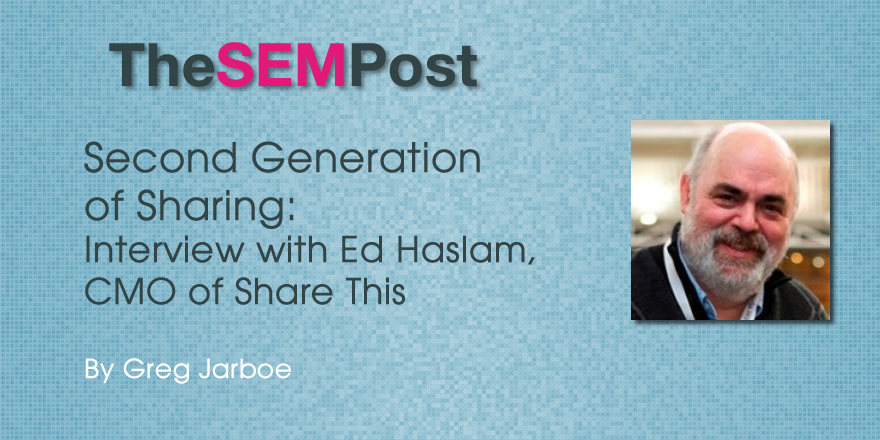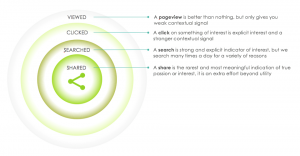
Greg Jarboe: I read recently that you think that think that the social data industry is right on the precipice of sharing happening at scale. Can you elaborate?
Ed Haslam: Social sharing is in the midst of an evolution; from first generation, simple widget-based sharing, to platforms of social optimization tools for publishers to drive growth and engagement — leveraging the very basic human desire to share. From the early 2000’s with the creation of the early social networks like Friendster and Myspace, to later in the decade with the growth and dominance of Facebook, Linkedin, and Twitter, we have had places to share things we discover on the internet to both social and professional networks. This has resulted in explosive growth in social sharing and the consequent uses of the data generated. Approximately 1.8B of the 2.5B global internet users today use social networks, and 470M of them share on Facebook alone (note: on the ShareThis network, Facebook accounts for 85-90% of our shares in any given month). In the US, 44% of the internet population shares and a 2014 study by Fractl showed that there were 2.6B shares of the 1M most popular articles in a 6 month period. In the US alone there are as many shares of content as there are global internet users! Sharing is now mainstream and happening at scale.
Greg Jarboe: You’ve also said that sharing can be the most valuable indication of interest and intent, even more so than search or clicks which have dominated for years. Can you go into more detail?
Ed Haslam: Sharing is a rare and very meaningful digital act. When sharing is compared to the other popular digital acts and measurements, seen in Figure 1, you start to see its true value. In a typical digital session workflow of an average person, several pages are browsed, creating many impressions, and lots but fewer clicks into the content of a given page. People will then search for things via a search engine which registers even stronger intent and explicit interest in a topic or content. Finally, if and when we decide to share something at the end of this workflow it is only because what we are sharing is very meaningful to us in some way and we decide to take the time to share it with friend or colleagues – relative to other digital acts, sharing is rare and meaningful. That makes this data very valuable for publishers.
Greg Jarboe: What are your thoughts on the evolution of digital sharing?
Ed Haslam: The early 2000’s first generation of sharing was characterized by:
- Simple social share widgets that showed up as icons on publisher articles/posts.
- Novelty for early social media/network adopters to use.
- Drove counts on publishers sites that indicated popularity of content.
- Ignored dark social email-based copy/paste shares that tend to dominate sharing.
The second generation of social sharing that emerged in the past year is now characterized by:
- Common practice across all internet demographics indexed to growth and adoption of Facebook by mainstream population, a scaled, network effect.
- Simple widgets evolve into platform of tools that enable publishers to both optimize content and audience growth.
- Dark social brought into the light and now measurable with on page embedded javascript.
- Sharing becomes powerful audience growth vehicle on par with seo/sem/paid campaigns – it is the earned media vehicles driving publisher engaged audience growth – not just clicks but truly interested new readers/consumers.
Greg Jarboe: What makes people want to share videos, photos, news, or opinions with their friends, family, and colleagues?
Ed Haslam: The desire to share is rooted deep within; it reflects passions, wants, and lifestyles that are constantly fluctuating throughout the day, week, and month. Exchanging information with and distributing compelling content to others is a form of expression that says a lot about an individual. People are becoming creators of content, and information exchange has become a well-known currency that truly caters to the innermost being. It creates a level of engagement that quickly becomes personal, and it is only increasing as colleagues, friends, and family are spreading the word about causes they care about, articles that spark curiosity, entertaining videos, family photos, and more. On the ShareThis network this happens over 3B times each month. It is time for comScore and/or Nielsen to start to measure cross-channel sharing across all publishers and sharing tool providers just like they measure searches, video views, and other popular click-types.
Greg Jarboe: What are the implications of this second generation of sharing for publishers, advertisers, and all data-driven businesses?
Ed Haslam: We have found that using data science to identify these human sentiments leads to a better understanding of people, which can ultimately lead to a more personal and relevant digital experience. Discovering information that is important and wanting to share it with others comes naturally, which has in turn pivoted the internet away from being simply a utility source and has instead turned it into a social sphere of engagement, personal expression, human connection, and so much more. Publishers are realizing this as well and using this data and consequent audience understanding to drive both content creation strategies and monetization of their content. ShareThis has been part of this evolution of consumer sharing and publisher tools since 2007, and has recently refreshed its brand and website to better represent this new generation of sharing.
Greg Jarboe: Oracle has just signed an agreement to acquire AddThis, your largest cross-platform competitor. And ShareThis has just launched a brand refresh as well with a new website. Should we see these major investments as signs of the strength of this market?
Ed Haslam: Today’s data-driven marketing organizations have an insatiable appetite for more authentic data to help them understand their customers. Witness the recent acquisition of AddThis by Oracle’s Marketing Cloud business unit. The dynamic sharing data, when overlaid with CRM systems and the like, provides a recent and better-defined view of their consumers’ true interests at any moment in time, leading to more personalized marketing and better-adapted customer-driven business decisions. As the digital act of sharing bridges the divide between impersonal digital data and personal human expression, sharing data elevates the customer ID and digital data associated with consumers, resulting in a true understanding of complex people.
Greg Jarboe
Latest posts by Greg Jarboe (see all)
- Recreating Viral Video Success: Squatty Potty - October 20, 2017
- Baby Boomers are the Audience Most Advertisers are Missing on YouTube - September 19, 2017
- KnowledgeVision’s Knovio 3.0 is Not Your Old School Online Video Platform - June 30, 2017
- Top 10 Super Bowl Ads for 2017 Depend on Which Metrics You Use - February 7, 2017
- Only 10% of Viewers Thought Last Year’s Super Bowl Ads Were Funny - January 17, 2017
